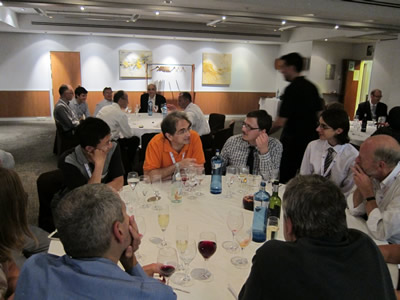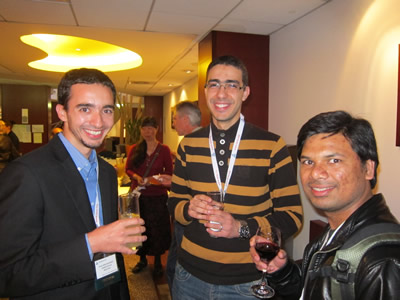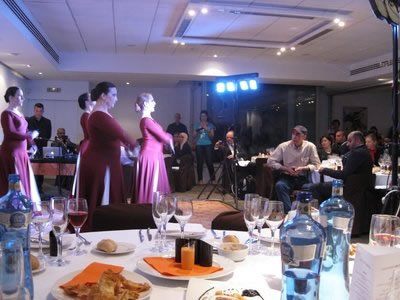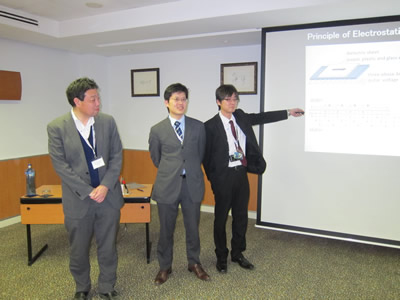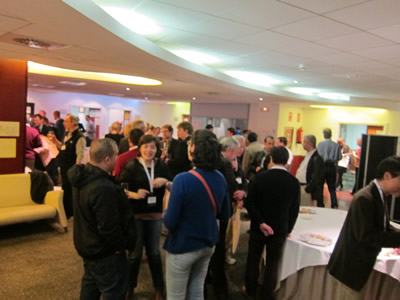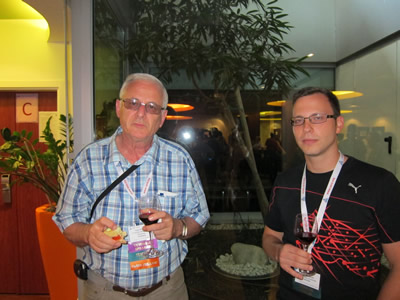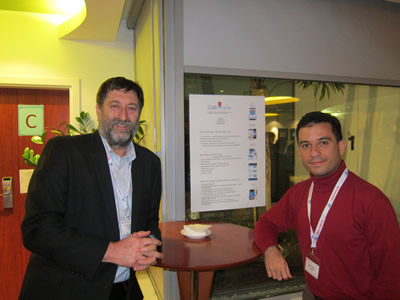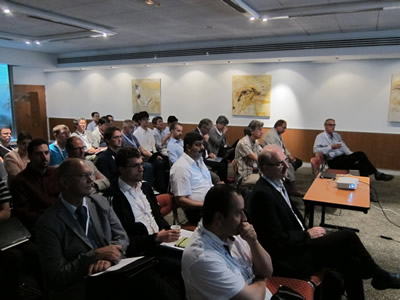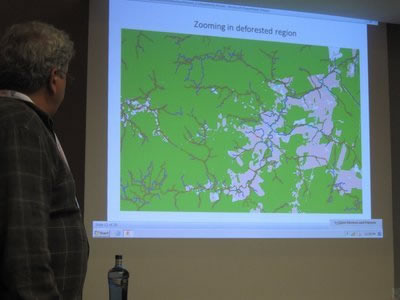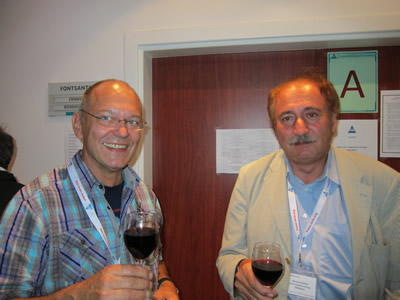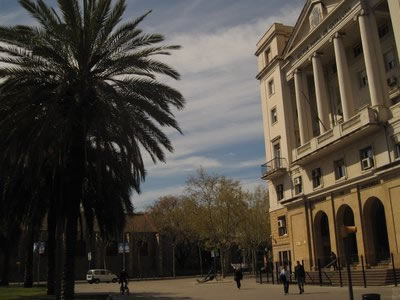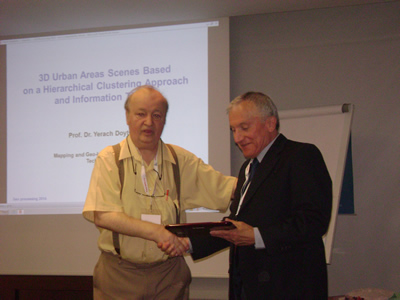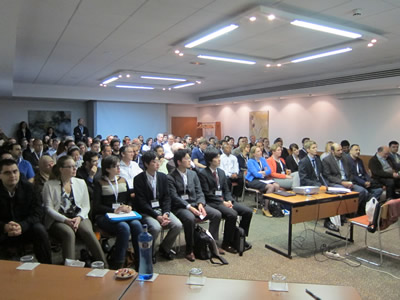ICNS 2023 - The Nineteenth International Conference on Networking and Services
March 13, 2023 - March 17, 2023
ICNS 2023: Call for Papers
Onsite and Online Options: To accommodate a large number of situations, we are offering the option for either physical presence or virtual participation (pdf slides or pre-recorded videos).
ICNS 2023 continues a series of events targeting general networking and services aspects in multi-technologies environments. The conference covers fundamentals on networking and services, and highlights new challenging industrial and research topics. Ubiquitous services, next generation networks, inter-provider quality of service, GRID networks and services, and emergency services and disaster recovery are considered.
IPv6, the Next Generation of the Internet Protocol, has seen over the past three years tremendous activity related to its development, implementation and deployment. Its importance is unequivocally recognized by research organizations, businesses and governments worldwide. To maintain global competitiveness, governments are mandating, encouraging or actively supporting the adoption of IPv6 to prepare their respective economies for the future communication infrastructures. In the United States, government’s plans to migrate to IPv6 has stimulated significant interest in the technology and accelerated the adoption process. Business organizations are also increasingly mindful of the IPv4 address space depletion and see within IPv6 a way to solve pressing technical problems. At the same time IPv6 technology continues to evolve beyond IPv4 capabilities. Communications equipment manufacturers and applications developers are actively integrating IPv6 in their products based on market demands.
IPv6 creates opportunities for new and more scalable IP based services while representing a fertile and growing area of research and technology innovation. The efforts of successful research projects, progressive service providers deploying IPv6 services and enterprises led to a significant body of knowledge and expertise. It is the goal of this workshop to facilitate the dissemination and exchange of technology and deployment related information, to provide a forum where academia and industry can share ideas and experiences in this field that could accelerate the adoption of IPv6. The workshop brings together IPv6 research and deployment experts that will share their work. The audience will hear the latest technological updates and will be provided with examples of successful IPv6 deployments; it will be offered an opportunity to learn what to expect from IPv6 and how to prepare for it.
Packet Dynamics refers broadly to measurements, theory and/or models that describe the time evolution and the associated attributes of packets, flows or streams of packets in a network. Factors impacting packet dynamics include cross traffic, architectures of intermediate nodes (e.g., routers, gateways, and firewalls), complex interaction of hardware resources and protocols at various levels, as well as implementations that often involve competing and conflicting requirements.
Parameters such as packet reordering, delay, jitter and loss that characterize the delivery of packet streams are at times highly correlated. Load-balancing at an intermediate node may, for example, result in out-of-order arrivals and excessive jitter, and network congestion may manifest as packet losses or large jitter. Out-of-order arrivals, losses, and jitter in turn may lead to unnecessary retransmissions in TCP or loss of voice quality in VoIP.
With the growth of the Internet in size, speed and traffic volume, understanding the impact of underlying network resources and protocols on packet delivery and application performance has assumed a critical importance. Measurements and models explaining the variation and interdependence of delivery characteristics are crucial not only for efficient operation of networks and network diagnosis, but also for developing solutions for future networks.
Local and global scheduling and heavy resource sharing are main features carried by Grid networks. Grids offer a uniform interface to a distributed collection of heterogeneous computational, storage and network resources. Most current operational Grids are dedicated to a limited set of computationally and/or data intensive scientific problems.
Optical burst switching enables these features while offering the necessary network flexibility demanded by future Grid applications. Currently ongoing research and achievements refers to high performance and computability in Grid networks. However, the communication and computation mechanisms for Grid applications require further development, deployment and validation.
We solicit both academic, research, and industrial contributions. We welcome technical papers presenting research and practical results, position papers addressing the pros and cons of specific proposals, such as those being discussed in the standard fora or in industry consortia, survey papers addressing the key problems and solutions on any of the above topics short papers on work in progress, and panel proposals.
Industrial presentations are not subject to the format and content constraints of regular submissions. We expect short and long presentations that express industrial position and status.
Tutorials on specific related topics and panels on challenging areas are encouraged.
The topics suggested by the conference can be discussed in term of concepts, state of the art, research, standards, implementations, running experiments, applications, and industrial case studies. Authors are invited to submit complete unpublished papers, which are not under review in any other conference or journal in the following, but not limited to, topic areas.
All topics and submission formats are open to both research and industry contributions.
ICNS 2023 conference tracks:
Trends in networking and services
Network function virtualization (NFV); Service availability in the NFV; Multi-services in LTE; Resilience in software defined networks (SDN); Indoor 5G wireless access; Scalability in 5G; Cognitive 5G; QoS in SDN-enabled 5G systems; Cross-layer frameworks; Services in big data platforms; Technologies in Cloud storage service; Cloud-based Web applications; Multi-operator shared heterogeneous networks; Virtualization-based control; Cloud radio access; Incremental synchronization in Clouds; Changes for cognitive wireless networks; Power efficiency via interferences; Cognitive networks and spectrum sensing; Massive beamforming ; Ultra-lean systems; Spectrum-sharing communications; Information retrieval protocols; Multi-access MAC protocols; Multi-user indoor communications; Energy harvesting; Sensing-as-a-Service; Ultrasound sensor networks; QoS-aware body area networks; Robust sensing services; Cloud of things; Cloud and smart grid vulnerabilities; Polarization-agile antennas; Service perceptual quality; Geographical routing protocols; Femto-Clouds; Services in urban environments; Services for data handling in smart cities; Wideband massive MMO; Cache performance; Energy-efficient resource allocation; Content delivery service; MIMO cognitive radio networks; All-spectrum cognitive solutions; Cognitive machine-to-machine networks; Adaptive multiple access schemes; Network service providers; Heterogeneous cellular networks; Caching in mobile cellular networks; Cognitive radio ad hoc networks; Opportunistic unlicensed spectra utilization; Adaptation in Cyber-physical systems; Service availability models
Slicing and 5/6/7G technologies
Network slicing models; 5G Network slicing Architecture; 5G/6G Networks slicing; End to End (E2E) network slicing; Automated networks slicing; Network Slice as a Service(NSaaS); Service slicing; IoT service slicing; Slicing-as-a-Service (SlaaS); Slicing and orchestration; Latency-sensitive 5G services; Differentiated slice-based 5G services; 5G E2E (End to End), 6G Cellular data networks; Indoor 5G Open Radio Access Network (O-RAN); 5G mmWave; 7G and 8G network and High speed internet. Network slicing market. Networks slicing ROI (Return on Investment); 6-7-8G and ROI.
Emerging Network Communications and Technologies
Software defined networks and Network functions virtualization; Future mobile networks: 4G, 5G, and LTE spectra; Mobile Cloud systems; Internet of Things (IOT); Sensing and sensor networks; Energy-aware networks; Content-oriented networking; Cellular cognitive networks; Access and home networks; Ad hoc networks; Application-specific networks (e.g. SANs); Autonomic Networks; Delay-tolerant Networking; Distributed communications systems & applications; High-speed & optical networks; Mobile networking and systems; Multimedia and multicast communications; Networking Communication theory; Network modeling & simulation; Network monitoring techniques; Network security; Next Generation Networks (NGN); Overlay networks; Peer-to-peer networking; Programmable and Active Networks; Sensor networks; Wireless and Satellite Networks; Content-oriented networks; Ambient environments
CLOUD/GRID Networks and Services
CLOUD frameworks, architectures, computation, storage; GRID theory, frameworks, methodologies, architecture, ontology; Cloud and GRID infrastructure and technologies; CLOUD/GRID middleware; CLOUD computing, utility computing, autonomic computing, metacomputing; Programmable CLOUD/GRID; CLOUD services and applications; VIRTUALIZATION, modeling, and metadata; Resource management, scheduling, and scalability in CLOUD/GRID; CLOUD/GRID monitoring, control, and management; Traffic and load balancing in CLOUD/GRID; User profiles and priorities in CLOUD/GRID; Performance and security in CLOUD/GRID systems; Fault tolerance, resilience, survivability, robustness in CLOUD/GRID; QoS/SLA in CLOUD/GRID networks; CLOUD/GRID fora, standards, development, evolution; CLOUD/GRID case studies, validation testbeds, prototypes, and lessons learned
Ubiquitous mobile services and protocols
Frameworks, architectures, and languages for ubiquitous services; Queries, transactions and workflows in mobile and ubiquitous Networks; Algorithms for ubiquitous systems; SLA/QoS in ubiquitous services; Ontology-based services; Location-based services; Protocols and interaction mechanisms for ubiquitous services; Mobile services and service convergence; Service discovery mechanisms; Tracking in ubiquitous environments; Measurement, control, and management of ubiquitous services; Design and development of ubiquitous services; Wireless/mobile service delivery
Multi-technology service deployment and assurance
Service-oriented architectures; Service definition, creation, bundling, deployment; Service reuse, composition and service feature interaction; Service orchestration and federation; Inter-provider service dependency; Intra-provider service dependency and service interaction; Service middleware and service development platforms (SDPs); Service open architecture (SOA); Profiling and service adaptation; Service privacy and security; Quality of service, service level agreement [QoS/SLA]; Service agreement violations; Mobile services and service migration; Reliability, availability, serviceability [RAS]; Service performance metrics; Traffic engineering, metering, monitoring; Voice over IP services; IP Multimedia services; Real-time/not-real-rime services; Real-time services over IP/IPv6; Service performance evaluation, tools, simulation
Next Generation Networks and Ubiquitous Services
Methodologies, development support, and tools for NGN and converging services; NGN and convergence of ubiquitous services; NGN frameworks, architectures, and concepts; NGN technologies and mechanisms; QoS/SLA, traffic in NGN; NGN transport/service layered capabilities and operations; NGN concepts for active, ad hoc, mobile, and wireless networks; 3G, 4G, and 5G Mobile networks; Fixed/mobile networks integration and internetworking; Services and service differentiation over NGN; Managing ubiquitous services in NGN; NGN interworking, non-NGN interoperability, migration; Regulatory services in NGN and standard activities; NGN device instrumentation; NGN policy-based control; Next Generation Internet
Network Control and Management
Network, control and service architectures; Measurement of stream characteristics (reordering, delay, losses, jitter, etc.); Network signaling, pricing and billing; Network middleware; Network management, monitoring and control; Network resource scheduling; Networks policy-based management; Management of autonomic networks and systems; Telecommunication networks architectures; On-demand networks, utility computing architectures; Traffic engineering; Impact of packet dynamics on application performance; Applications and case studies
Multi Provider QoS/SLA Internetworking
Architectures, frameworks, mechanisms for admission control and measurement; QoS in multi-provider and multi-technology networks; Service classes and multi-provider service class discovery; Service level agreement and service assurance in multi-provider environments; Carrier-class end-to-end SLA and QoS monitoring and management; Multi provider accounting/billing/cost sharing; Management, monitoring, and measurements in multi-provider networks; End-to-end QoS/SLA advanced network services in multi-provider networks; End-to-end QoS/SLA for multimedia applications and services in multi-provider networks; Security issues in multi-service provider networks; Business models for multi-providers under QoS/SLA constraints; Standards and fora activities
Software Defined Networking
SDN architectures; Openflow protocols; SDN switches and routers; SDN controllers; Network operating systems; SDN scalability; Virtualization; Flow based operation; Distributed Controllers; State distribution in SDN control; Fault tolerance in SDN; Secure and dependable SDN; Openflow vulnerabilities; Software defined Internet architectures;Scaling virtualized functions; Traffic engineering with SDN; Abstractions for SDN; Network programming languages; Information centric networking and SDN; SDN in cloud computing; SDN applications; SDN in wireless environment; Controller performance evaluations; Mobility solutions
Emergency Services and Disaster Recovery of Networks and Applications
Theory on disaster-tolerant robust networks; Recovery by disruption resource procedures; Security issues with emergency services and disaster recovery; Networks resiliency methods; Formal methods for safety-critical systems; Networks emergency services; Public safety, reliable emergency communications, and applications; Response to the networks emergency services; Disaster prevention and recovery; Fighting mechanisms for disaster of networks and applications; Notifications and recovery in various network technologies; Customer protection and serviceability perception; Cost models and business impact; Cultural and legal aspects; Future advanced network development and evolution; Standards and guidelines; Lawful interception and defense strategies;
Deploying the Future Infrastructures
Advanced Topics and Latest Developments in IPv6; IPv6 Deployment Experiences and Case Studies; IPv6 Enabled Applications and Devices; Deploying large-scale Internet of Things (IoT)-based networks and services; Optical Network Infrastructures; Deploying 5G and beyond networks; Deploying sensor networks; Deploying wireless and wired body-networks
CLOUD/GRID over Optical Burst Switching Networks
Terabit burst switching; Burst assembly for IP DiffServ over optical burst switching networks; Optical network infrastructure for CLOUD/GRID; Synchronous stream optical burst switching; Optical burst switching based CLOUD/GRID architectures; Reliable optical burst switching for next-generation Grid networks; Optical burst switching for IP-over-WDM/DWDM; Customizable Grid-to-optical network; Ultra high capacity optical networks; Hybrid optical burst/circuit switched for CLOUD/GRID-enabled optical networks; Job scheduling in optical burst switching CLOUD/GRID networks; Architecture and middleware for CLOUD/GRID-Over-OBS
Users, applications, and business models
Mobile user interfaces; Ubiquitous user-generated content (weblogs, wikis, etc.); Mobile and ubiquitous computing; User modeling and personalization; Context- and location-aware applications; Toolkits, testbeds, development environments; Tools and techniques for designing, implementing, & evaluating ubiquitous networks and services; Constructing, deploying and prototyping of ubiquitous applications; Evaluation of user models for ubiquitous environments; On-line analytical techniques; Human-computer interaction in ubiquitous computing environments; Ubiquitous e-Development (business, science, health, etc.); Case Studies; Emerging industrial/business/scientific ubiquitous scenarios
Deadlines:
Submission | Dec 15, 2022 |
Notification | Jan 23, 2023 |
Registration | Feb 05, 2023 |
Camera ready | Feb 15, 2023 |
Deadlines differ for special tracks. Please consult the conference home page for special tracks Call for Papers (if any).
INSTRUCTION FOR THE AUTHORS
Authors of selected papers will be invited to submit extended versions to one of the IARIA Journals.
Publisher: XPS (Xpert Publishing Services)
Archived: ThinkMindTM Digital Library (free access)
Prints available at Curran Associates, Inc.
How to submit to appropriate indexes.
Only .pdf or .doc files will be accepted for paper submission. All received submissions will be acknowledged via an automated system.
Contribution types
- regular papers [in the proceedings, digital library]
- short papers (work in progress) [in the proceedings, digital library]
- ideas: two pages [in the proceedings, digital library]
- extended abstracts: two pages [in the proceedings, digital library]
- posters: two pages [in the proceedings, digital library]
- posters: slide only [slide-deck posted on www.iaria.org]
- presentations: slide only [slide-deck posted on www.iaria.org]
- demos: two pages [posted on www.iaria.org]
FORMATS
Only .pdf or .doc files will be accepted for paper submission. All received submissions will be acknowledged via an automated system.
Final author manuscripts will be 8.5" x 11", not exceeding 6 pages; max 4 extra pages allowed at additional cost.
Helpful information for paper formatting for MS Word can be found here.
There is a community provided LaTeX template: the CTAN package iaria (with full IARIA formatting rules, including IARIA citation style, but for providing citation style it is tightly bound to pdflatex+biblatex+biber). In addition, there is also iaria-lite (not bound to pdflatex+biblatex+biber, but compatible with any TeX stack; thus, it cannot provide the IARIA citation formattings, but only the titlepage and content-related IARIA formatting rules). Based on the iaria package, there is a minimal working example as Overleaf template. When you are using the LaTeX templates, please still adhere to the additional editorial rules.
Slides-based contributions can use the corporate/university format and style.
Your paper should also comply with the additional editorial rules.
Once you receive the notification of contribution acceptance, you will be provided by the publisher an online author kit with all the steps an author needs to follow to submit the final version. The author kits URL will be included in the letter of acceptance.
We would recommend that you should not use too many extra pages, even if you can afford the extra fees. No more than 2 contributions per event are recommended, as each contribution must be separately registered and paid for. At least one author of each accepted paper must register to ensure that the paper will be included in the conference proceedings and in the digital library, or posted on the www.iaria.org (for slide-based contributions).
CONTRIBUTION TYPE
Regular Papers (up to 6-10 page article -6 pages covered the by regular registration; max 4 extra pages allowed at additional cost- ) (oral presentation)
These contributions could be academic or industrial research, survey, white, implementation-oriented, architecture-oriented, white papers, etc. They will be included in the proceedings, posted in the free-access ThinkMind digital library and sent for indexing. Please submit the contributions following the instructions for the regular submissions using the "Submit a Paper" button and selecting the appropriate contribution type. 12-14 presentation slides are suggested.
Short papers (work in progress) (up to 4 pages long) (oral presentation)
Work-in-progress contributions are welcome. These contributions represent partial achievements of longer-term projects. They could be academic or industrial research, survey, white, implementation-oriented, architecture-oriented, white papers, etc. Please submit the contributions following the instructions for the regular submissions using the "Submit a Paper" button and selecting the contribution type as work in progress. Contributors must follow the conference deadlines, describing early research and novel skeleton ideas in the areas of the conference topics. The work will be published in the conference proceedings, posted in the free-access ThinkMind digital library and sent for indexing. For more details, see the Work in Progress explanation page. 12-14 presentation slides are suggested.
Ideas contributions (2 pages long) (oral presentation)
This category is dedicated to new ideas in their very early stage. Idea contributions are expression of yet to be developed approaches, with pros/cons, not yet consolidated. Ideas contributions are intended for a debate and audience feedback. Please submit the contributions following the instructions for the regular submissions using the "Submit a Paper" button and selecting the contribution type as Idea. Contributors must follow the conference deadlines, describing early research and novel skeleton ideas in the areas of the conference topics. The work will be published in the conference proceedings, posted in the free-access ThinkMind digital library and sent for indexing. For more details, see the Ideas explanation page. 12-14 presentation slides are suggested.
Extended abstracts (2 pages long) (oral presentation)
Extended abstracts summarize a long potential publication with noticeable results. It is intended for sharing yet to be written, or further on intended for a journal publication. Please submit the contributions following the instructions for the regular submissions using the "Submit a Paper" button and selecting the contribution type as Extended abstract. Contributors must follow the conference deadlines, describing early research and novel skeleton ideas in the areas of the conference topics. The work will be published in the conference proceedings, posted in the free-access ThinkMind digital library and sent for indexing. 12-14 presentation slides are suggested.
Posters (paper-based, two pages long) (oral presentation)
Posters are intended for ongoing research projects, concrete realizations, or industrial applications/projects presentations. The poster may be presented during sessions reserved for posters, or mixed with presentation of articles of similar topic. A two-page paper summarizes a presentation intended to be a POSTER. This allows an author to summarize a series of results and expose them via a big number of figures, graphics and tables. Please submit the contributions following the instructions for the regular submissions using the "Submit a Paper" button and selecting the contribution type as Poster Two Pages. Contributors must follow the conference deadlines, describing early research and novel skeleton ideas in the areas of the conference topics. The work will be published in the conference proceedings, posted in the free-access ThinkMind digital library and sent for indexing. 8-10 presentation slides are suggested. Also a big Poster is suitable, used for live discussions with the attendees, in addition to the oral presentation.
Posters (slide-based, only) (oral presentation)
Posters are intended for ongoing research projects, concrete realizations, or industrial applications/projects presentations. The poster may be presented during sessions reserved for posters, or mixed with presentation of articles of similar topic. The slides must have comprehensive comments. This type of contribution only requires a 8-10 slide-deck. Please submit the contributions following the instructions for the regular submissions using the "Submit a Paper" button and selecting the contribution type as Poster (slide-only). The slide-deck will be posted, post-event, on www.iaria.org.
8-10 presentation slides are suggested. Also a big Poster is suitable, used for live discussions with the attendees, additionally to the oral presentation.
Presentations (slide-based, only) (oral presentation)
These contributions represent technical marketing/industrial/business/positioning presentations. This type of contribution only requires a 12-14 slide-deck. Please submit the contributions following the submission instructions by using the "Submit a Paper" button and selecting the contribution type as Presentation (slide-only). The slide-deck will be posted, post-event, on www.iaria.org.
12-14 presentation slides are suggested.
Demos (two pages) [posted on www.iaria.org]
Demos represent special contributions where a tool, an implementation of an application, or a freshly implemented system is presented in its alfa/beta version. It might also be intended for thsoe new application to gather the attendee opinion. A two-page summary for a demo is intended to be. It would be scheduled in special time spots, to ensure a maximum attendance from the participants. Please submit the contributions following the submission instructions by using the "Submit a Paper" button and selecting the contribution type as Demos. The Demos paper will be posted, post-event, on www.iaria.org.
Tutorial proposals
Tutorials provide overviews of current high interest topics. Proposals should be for 2-3 hour long. Proposals must contain the title, the summary of the content, and the biography of the presenter(s). The tutorial slide decks will be posted on the IARIA site.
Please send your proposals to tutorial proposal
Panel proposals
The organizers encourage scientists and industry leaders to organize dedicated panels dealing with controversial and challenging topics and paradigms. Panel moderators are asked to identify their guests and manage that their appropriate talk supports timely reach our deadlines. Moderators must specifically submit an official proposal, indicating their background, panelist names, their affiliation, the topic of the panel, as well as short biographies. The panel slide deck will be posted on the IARIA site.
Please send your proposals to panel proposal



